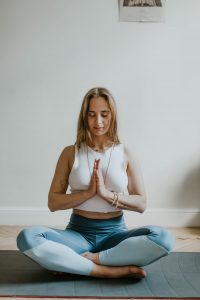Adaptive Yoga is for Everyone by Sarah Werner
Yoga is one of the most popular forms of exercise out there these days, and as it has grown, there has also been a movement to make yoga accessible to more people than ever before. One outgrowth of this is adaptive yoga, where instructors tailor poses and practices to the abilities of people who use wheelchairs, have limb differences, or other mobility-limiting conditions. Now that most yoga studios have been forced to close temporarily due to COVID-19, online yoga classes are proliferating and are an excellent way for people with disabilities to get started with their own yoga practice at home.
Yoga is Everywhere
Yoga is an ancient art that has been practiced for over four thousand years. It originated in India, but has now spread throughout the world with a diverse array of schools, or styles, of practice. Hatha yoga is perhaps the most well-known style of yoga in North America and combines breathing with holding the body in particular poses, called asanas. As yoga has gained in popularity and moved into the mainstream, accessible or adaptive yoga classes have also sprung up to offer the practice to people with a variety of physical limitations. There are chair-yoga and yoga-for-arthritis classes being offered at senior centers. Gentle or restorative yoga classes that can be found at many community yoga studios. Teaching yoga to people with specific conditions—including multiple sclerosis, autism, and spinal cord injuries—are even addressed in certain yoga teacher training programs. Now more than ever is a great time for people of all abilities to practice yoga.
My Experience with Adaptive Yoga
My own journey with adaptive yoga started last month when a friend told me about a new class that was being offered online by a local yoga studio with an instructor who is quadriplegic. Though I regularly practiced yoga before becoming disabled, I found it hard going to classes as a wheelchair user with able-bodied students and instructors. Everyone was friendly, but I never felt like I fit in with my muscle spasms and wheelchair. I struggled to adapt the poses to my own limitations, and didn’t attend more than a few classes before I became disheartened. I had heard from my physical therapist that adaptive yoga was being offered at some rehabilitation hospitals and outpatient programs, but I didn’t imagine that it would be available to me locally.
I wasn’t quite sure what to expect, but after my first class, I was hooked. Yoga is much more than aligning your body in particular poses. At its root it’s a practice of breath awareness. Each pose is meant to be matched to your breathing pattern, and being able to focus on the present moment is crucial. At the first class we learned a few basic poses, and have built each week on that foundation. Sometimes we focus on stretching the spine, other times we work on balance, but after every class I feel both challenged and centered. My arms have gotten stronger, and I feel like I have more balance, both of which are important for transferring in and out of my wheelchair and doing other daily activities. When I start to feel overwhelmed by the news or frustrations with family, I remember my yoga breathing, and I feel more centered. Many of the participants in my class are wheelchair users or have other disabilities, and taking the class with other people like me, even though it’s online, helps me feel like I’m part of a larger community.
Online Resources for Yoga Practice
Being confined to the house during this pandemic makes getting exercise difficult, and the absence of social activities and work can increase stress and anxiety. Yoga can help with both of these, helping us move our bodies and focus on something positive. And yoga is now more accessible than ever because many studios are offering classes online either for free or at a discount. Some yoga classes combine traditional poses with Pilates or other cardio exercises to get your heart pumping as well as your muscles moving. Other benefits of yoga are increased flexibility and strength as well as being able to connect, either in person or virtually, to a community of people.
There are many online resources that are helpful in beginning or sustaining your yoga practice at home. Matthew Sanford is one of the most well-known adaptive yoga instructors, learning yoga after sustaining a spinal cord injury as a teenager. His Mind Body Solutions Institute, based in Minnesota, offers one of the only comprehensive adaptive yoga teacher training programs in North America. During the pandemic they are also offering numerous instructional videos and classes online for free through their YouTube channel, The Hub.
Jivana Heyman is the founder of the non-profit Accessible Yoga and author of Accessible Yoga: Poses and Practices for Every Body (Shambhala, 2019). In this informative book he expands and explains a variety of the most common yoga poses in order to make them accessible to everyone regardless of physical ability.
Move United, formerly Disabled Sports USA, has a helpful article on beginning yoga postures you can try at home.
If you’re looking for more diverse content, you can subscribe to Yoga International’s online program, which offers classes by a wide variety of yoga instructors, including classes tailored to specific body types and conditions. Dianne Bondy and other well-known adaptive yoga instructors have classes streaming on this platform.
Whatever your level of physical ability, there is a yoga program out there for you. Gaining strength and flexibility as well as mental clarity are benefits available to everyone. So, go out and find resources that work for you and begin a lifelong practice that will benefit you for years to come.












You must be logged in to post a comment.